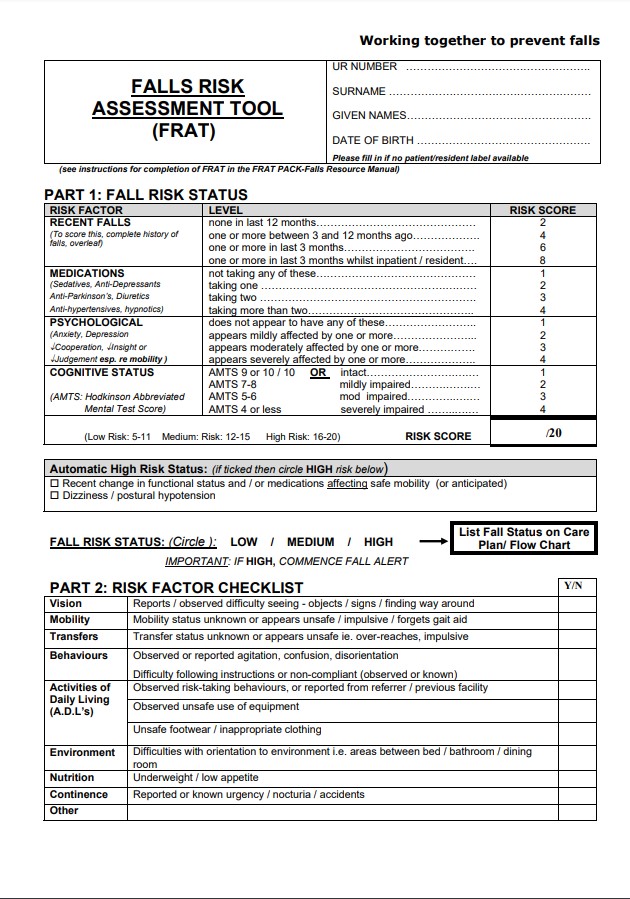Dementia Fall Risk Things To Know Before You Buy
The smart Trick of Dementia Fall Risk That Nobody is Discussing
Table of ContentsAll About Dementia Fall RiskDementia Fall Risk Things To Know Before You Get ThisDementia Fall Risk Fundamentals ExplainedThe Facts About Dementia Fall Risk UncoveredEverything about Dementia Fall Risk
Make certain that there is an assigned area in your medical charting system where team can document/reference ratings and record appropriate notes connected to drop avoidance. The Johns Hopkins Loss Danger Assessment Device is one of lots of tools your staff can utilize to aid stop unfavorable clinical events.Individual drops in hospitals are usual and devastating damaging occasions that continue despite decades of initiative to reduce them. Improving communication throughout the examining nurse, care team, person, and patient's most included buddies and family might reinforce autumn avoidance initiatives. A team at Brigham and Women's Medical facility in Boston, Massachusetts, looked for to create a standardized loss avoidance program that focused around improved communication and patient and household engagement.

The development group highlighted that effective execution relies on patient and team buy-in, assimilation of the program right into existing workflows, and fidelity to program processes. The team kept in mind that they are grappling with just how to guarantee connection in program execution throughout periods of dilemma. During the COVID-19 pandemic, for instance, a boost in inpatient falls was connected with constraints in person involvement along with restrictions on visitation.
The Definitive Guide for Dementia Fall Risk
These events are commonly considered avoidable. To execute the treatment, companies need the following: Accessibility to Autumn pointers resources Loss TIPS training and re-training for nursing and non-nursing team, including new nurses Nursing workflows that enable for client and family interaction to conduct the falls assessment, make sure use the prevention strategy, and conduct patient-level audits.
The outcomes can be very damaging, usually speeding up individual decrease and causing longer medical facility keeps. One research study estimated stays raised an extra 12 in-patient days after an individual fall. The Autumn TIPS Program is based upon interesting clients and their family/loved ones throughout 3 major procedures: assessment, individualized preventative interventions, and bookkeeping to make certain that clients are engaged in the three-step autumn prevention process.
The person assessment is based upon the Morse Fall Scale, which is a validated autumn risk analysis device for in-patient health center setups. The range consists of the six most usual reasons clients in health centers fall: the client autumn background, risky problems (consisting of polypharmacy), use IVs and various other external devices, mental status, stride, and mobility.
Each threat factor links with one or even more actionable evidence-based treatments. The registered nurse develops a strategy that incorporates the interventions and shows up click here for info to the care group, person, and family members on a laminated poster or published visual help. Registered nurses establish the plan while meeting the person and the individual's household.
All about Dementia Fall Risk
The poster offers as a communication device with other participants of the individual's care team. Dementia Fall Risk. The audit part of the program includes analyzing the client's understanding of their risk elements and avoidance strategy at the unit and health center levels. Registered nurse champions conduct at the very least 5 private meetings a month with clients and their families check to look for understanding of the fall prevention strategy

An approximated 30% of these falls result in injuries, which can vary in extent. Unlike various other damaging events that need a standardized scientific action, autumn avoidance depends highly on the demands of the patient.
Dementia Fall Risk - An Overview

Based upon bookkeeping outcomes, one site had 86% conformity and 2 websites had over 95% conformity. A cost-benefit evaluation of the Autumn pointers program in eight medical facilities estimated that the program cost $0.88 per client to apply and caused cost savings of $8,500 per 1000 patient-days in direct prices associated to the avoidance of 567 tips over three years and eight months.
According to the technology team, organizations thinking about executing the program should carry out a preparedness analysis and falls avoidance voids analysis. 8 Furthermore, organizations should guarantee the needed facilities and operations for execution and establish an execution strategy. If one exists, the company's Fall Prevention Task Pressure ought to be involved in planning.
Dementia Fall Risk Fundamentals Explained
To begin, organizations need to guarantee completion of training modules by nurses and nursing assistants - Dementia Fall Risk. Healthcare facility personnel must analyze, based on the requirements of a healthcare facility, whether to make use of a digital health and wellness record hard copy or paper version of the loss prevention plan. Applying groups need to recruit and train nurse champions and develop procedures for bookkeeping and reporting on loss information
Staff need to be associated with the procedure of redesigning the process to involve people and household in the analysis and avoidance strategy procedure. Equipment must remain in place to make sure that devices can comprehend why an autumn occurred and discover this remediate the reason. More specifically, registered nurses need to have networks to provide recurring responses to both staff and device management so they can change and improve fall prevention process and interact systemic troubles.